Latvian flag
Latvian flag – history and development
Flag of Latvia – The red and white flag of Latvia is considered one of the oldest flags in the world, which is still used according to the colors described in the ancient chronicles.
In heraldry, red means courage, struggle, heroism, and white means nobility, openness. However, the red and white colors did not originate from the classical understanding of heraldry. The origin of the colors of the Latvian flag is explained by folk tales, which we each choose to believe or not.

Legends about the red edges of the Latvian flag are associated with blood. 1936. In the popular scientific monograph “History of the Latvian Flag” published by “Grāmatu Draugs” in 2012, two of the most popular legends can be found:
The first saying reads: “Estonians besieged the Latvian castle. The inhabitants of the castle have been starving for several weeks. It remains either to surrender or to break through the ranks of the enemy. An old woodcutter has offered to attack the enemy after a joint prayer. A ram was killed in the sacrificial ritual. During the prayer and sacrifice, the woodcutter took off his white shirt and dipped it in the ram’s blood. The place in the middle of the cloth, which was held in the hand at the time of immersion, remained white. They attached this red and white cloth to the card and went on the attack. And managed to drive away the enemy. Since then, Latvian soldiers have increasingly started using this flag”.
The second legend is about the times when Latvian tribes fought for freedom against the knights: “In a certain battle, the Latvians took away a white flag from the enemy. But in that battle, a Latvian chieftain was wounded. He was laid on the white flag. The chieftain called all the warriors and promised that they would all fight, until the native land is free. When everyone swore it, the chief died. The flag became completely red from the chief’s blood. Only where his body was, a white stripe remained. The enraged Latvians went into battle with this flag and drove the enemy away.[1]
The flag of Latvia – Outside of legends, the flag of Latvia was mentioned for the first time in the rhyming chronicle – 13. at the end of the century, a group of soldiers came from Cēsis and Riga with a red flag with a white stripe in the middle. “that Latvian flag is true”, the chronicle says.
The first flags were also created based on the Rhyme Chronicle. For example, the Latvian flag, which was embroidered in 1916. The author of the flag idea is teacher Jānis Lapiņš. The flag was made by his wife, Marianna Lapiņa, a teacher at the children’s shelter in Valmiera. This flag has been supplemented – with a sun that resembles the badge of archers.[2]
The red-white-red flag was raised for the first time in Valmiera, in March 1917, over the local Latvian association building during the Vidzeme Land Assembly. The future fate of this flag is legendary. In 1917, the orphanage where Marianna Lapiņa works is evacuated from Valmiera to Kazan. The flag seamstress also goes with her creation, soon after Jānis Lapiņš. In the twenties and thirties, the flag was kept by the Lapiņi family, then, during the Soviet era, it was carefully hidden. During the years of German occupation, Marianna and her daughter, together with the factory where they worked, evacuated to Germany, where they carried her flag, rolled up like a small handkerchief, under their clothes. After the war, both returned to Latvia, including the flag, but it had to be hidden for many years. In 1997, the daughter of Marianna and Jānis Lapiņu, Lija Poga, donated this flag, which was already more than 80 years old at the time, to the Cēsis Museum.[6]
Click here if you want to buy a Latvian flag
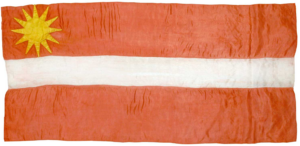
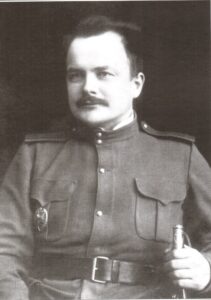

The flag of Latvia – Red-white-red became more and more popular – it was used by the archers at the Latgale congress in 1917. in the annual demonstrations. At that time, everyone had their own shade of red and the proportions of the stripes were different, and everyone added whatever came to mind to the flag.
“Already in 1917, not only the sun was put on the flag, but also a heart, a sword, various inscriptions were put on it. But the prevailing opinion was that the flag should be simple, without various symbols,” said Tālis Vigo Pumpuriņš, historian of the Cēsu History and Art Museum.
What should be the flag of Latvia was stated in the law for the first time in 1921. in 2008 – “At that time, the rapporteur was Marģers Skujenieks, and he said about the flag – it is already known from the Chronicle of Atskaņi, and it was widely used during the wars of independence, and there was absolutely no discussion,” said Tālis Vigo Pumpuriņš.
During the Soviet occupation, the red and white flags moved abroad with the exiles, but those that remained in Latvia were hidden somewhere. But already in 1988. In 2008, with the decree of the Presidium of the Supreme Council of the LPSR, the red and white flag in Latvia begins to regain its place and role. [2]
1918. 18 of the year November also created chaos in the use of the red and white flag. Immediately after the declaration of independence, all kinds of red and white flags appeared at houses and in demonstrations – made of different fabrics, in different proportions and sizes, without talking about the red color at all – it could be reddish pink, red brown, or even blood pink. After the declaration of independence, Latvians immediately wanted to be proud of the red and white flags. That is why every Latvian seamstress made the Latvian flag, as she knew how and with what she could. Everything was complicated by the fact that the war-ravaged shops ran out of red cloth due to high demand. It turns out that in 1918 at the end of the year, one of the goods with the greatest deficit was red cloth. [1]
On June 15, 1921, the Constituent Assembly adopted the Law on the Flag and Coat of Arms of the Republic of Latvia. The law determined the proportions of the colors, but did not specify the color shades, as well as the dimensions of the flag.
The color of the flag was described for the first time on August 25, 1922 in the regulations adopted by the Cabinet of Ministers of the Republic of Lithuania. The legal proportions of the length and width of the flag are 2:1, and the proportions of the red and white colors are 2:1:2. The colors of the flag correspond to the colors of the Pantone color scale PANTONE 201C and PANTONE White.[4]
Click here if you want to buy a Latvian flag
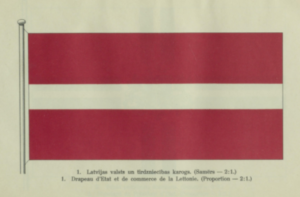
It was the decoration of the hall of the act of proclamation of Latvia in red and white colors that was the stimulus for our colors to become “Red of Latvia” with a white stripe in the middle, as it can be seen in Viļas Rīdzeniek’s photograph.[1]
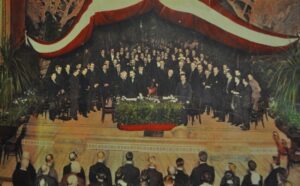
But the red and white flag had competition. 20. At the beginning of the 20th century, the red-white flag did not become a favorite among Latvians living in America, but the blue-green-golden flag.
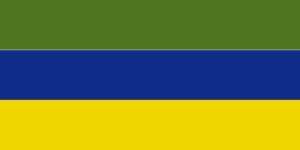
Latvian flag – It was based on the flag of the student corporation “Lettonia” created in the eighties of the 19th century, which at that time, when the Latvians did not have their own flag, temporarily became the national flag to some extent. This flag is derived from the combination of red and white colors. At first, the Latvian students of Tērbata wanted only red and white as the colors of their corporation, but since the traditions of corporations required student unions to make flags in three colors, after red and white, the Latvian students noted a third color – golden yellow. However, the tsarist regime did not like such a flag, especially its revolutionary red color. So the Latvian students left only the golden yellow color, but replaced the red with green, which symbolized Vidzeme and Kurzeme, and the white with blue, which is said to have been taken from the ancient flag of Kurzeme. However, as it turned out, the Latvians of Latvia did not like the tradition of their overseas compatriots. [5]
Click here if you want to buy a Latvian flag
Latvian flag hanging days
March 25 – Commemoration Day for Victims of Communist Genocide (mourning)
May 1 — Labor Day, convening day of the Latvian Constituent Assembly
May 4 – Independence Day of the Republic of Latvia (1990)
June 14 – Communist Genocide Memorial Day (mourning)
June 17 – Occupation Day of the Republic of Latvia (mourning)
July 4 – Day of Remembrance of the Victims of the Genocide of the Jewish People (mourning)
August 21 — the day of adoption of the Constitutional Law “On the State Status of the Republic of Latvia”.
November 11 – Lačplėš Day
November 18 – Proclamation Day of the Republic of Latvia (1918)
The first Sunday of December is the day of commemoration of the victims of the genocide of the totalitarian communist regime directed against the Latvian people (in the form of mourning) [4]
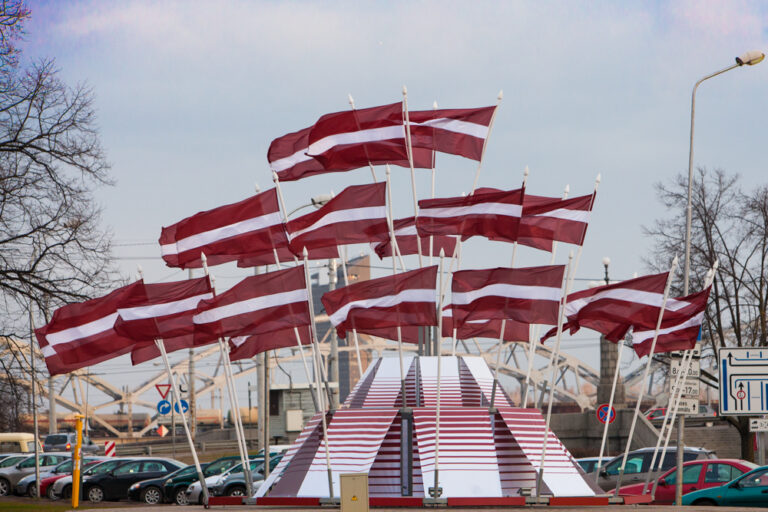
Click here if you want to buy a Latvian flag
Flag of Latvia – Use of the flag
The procedure for using the flag is established to show it due respect. These are generally accepted conditions of attitude. In all countries of the world, the flag is treated with great respect. The flag symbolizes the people and the country. “The flag is a symbolic message, the values with which the nation associates itself, by which it is recognized all over the world,” said Sintija Stipre. “The story is not about a specific piece of cloth, but about how we relate to the values and symbols of the people.”
The principles of using the national flag are determined both by the Law on the National Flag of Latvia and by Cabinet of Ministers Regulation no. 405 Rules of application of the Law on the State Flag of Latvia. However, there are also unwritten norms that are recommended to be followed.
1. The flag must be clean
Always make sure that the flag is clean, not torn or frayed by the wind. The white line of the flag can serve as a reference point – if it is no longer white, spotted or gray, it means that the flag needs to be changed or cleaned.
If the flag is used on a daily basis, you can buy two flags and exchange them from time to time – this way the flag will keep its proper appearance longer. When you buy a flag made of synthetic material, it is already treated with an agent that repels dirt. However, if the flag is being cleaned, it can be re-treated with a stain repellent at the end. If the fabric is torn and it can be seamlessly stitched, such a flag may be used. The law forbids the Latvian flag to be decorated with gold fringes or inscriptions or to be supplemented in any other way. If the flag is signed by an athlete or “God bless Latvia” is embroidered in gold letters, it is not prohibited, however, such a flag is used only in private spaces, but not publicly on the flagpole or pole. Observing the proportions of 2:1:2 and a specific color code on the Pantone scale, the flag can also be sewn by yourself.
2. It is not good for the mast to be empty
The international practice of using the flag provides that it is not accepted to keep the flagpole empty. So if a flagpole is placed near a building, it should have a flag hoisted. Care must be taken that the mast is straight and not visually damaged. If the national flag is in daily use around the clock and is permanently on the mast, care should be taken to ensure that it is illuminated during the dark hours of the day. If it is not possible to provide lighting, the flag should be lowered when the sun sets. The same goes for the flags on the pole near the building. “Of course, if the mast is empty every day or the flag is not lit, no one will punish you for it, but good practice would be to respect this etiquette condition,” adds Sintija Stipre. A black ribbon is not attached to the flag, which is used at the mast, on days of mourning and remembrance, but the flag is lowered to half-mast. If the flag has not yet been hoisted on the mast, it is hoisted up to the top of the mast and then lowered by a third of the height of the mast. When the mourning ends, the flag is raised again to the top of the mast and only then lowered completely.
3. For everyday use – a flag pennant
If raising the flag every morning and taking it down every evening seems too time-consuming or there is no such possibility, but the mast is installed near the house, a flag pennant can be used everyday – a trapezoidal fabric ribbon in the colors of the flag, but it is not used on the flag pole. The flag pennant is not subject to lighting (it can also be unlit on the mast during the dark hours of the day), in addition, this way it will be possible to save the flag, which will not wear out so quickly. However, this pennant does not replace the flag – the national flag of Latvia must be used on commemorations and holidays prescribed by law. “Using the flag pennant everyday, but the flag only on holidays and commemoration days, emphasizes the special status and solemnity of the flag,” said Sintija Stipre.
If there is a flag pennant on the mast every day, but on holidays it is planned to use the flag on the facade of the building, the pennant should be lowered, it is not a mandatory requirement, but it is better to be moderate.
4. With white gloves in hands
The flagpole used on the facade of the building or permanently placed indoors must be white in color with a decorative tip. On the other hand, the flag poles, which are carried in the hand, must be made of unpainted wood. “It is preferable to wear white gloves when carrying the flagpole. It has a symbolic meaning – my hands are clean, untainted, and I am worthy to carry the flag,” says Sintija Stipre.
5. Is it allowed to use the flag of another country?
It is also allowed to use the flag of the European Union or another country at residential buildings, both on a daily basis and on holidays. The main condition is that the flag is officially approved and its use is not prohibited by law (Article 11 of the law). 5 of the first part of Article point: “It is forbidden to use the flags, coats of arms, anthems and symbols of the former USSR, Latvian SSR and Nazi Germany (also in a stylized form).”). The flag of another country may be used alone or simultaneously with the national flag of Latvia. The main thing is that the flag of Latvia is used on national holidays and days of remembrance. “If we want to especially emphasize a national holiday or a day of remembrance, we can remove the flags of other countries and raise only the flag of Latvia on that particular date,” says Sintija Stipre.
If the flag of another country is used together with the Latvian flag, the vertical edge or width of the flag must be the same size as the Latvian flag. Each country’s flag has different proportions. They must not be changed. Therefore, the vertical edge of the flag is used as the main reference point. Such rules are adopted in order to show equal respect to all flags. If we use a wider and bigger flag, its status will be raised and made superior, if smaller or narrower – this flag will be despised. It is a good practice to use symbols of the same type at the same time, that is, if we also use the flag of another country at the same time, the flag of Latvia should be hoisted on the mast, not the pennant of the flag. The principle of equality also states that the fabric of the flag must be of the same material and of the same density.
Click here if you want to buy a Latvian flag
It is prohibited to use the national flag of Latvia:
• at buildings that are in a state of emergency,
• the facade of which is being repaired,
• in other unsuitable places and conditions.
References:
#1
2.https://www.lsm.lv/raksts/dzive–stils/vesture/valsts-simboli-karogs–pirmo-reizi-minets-13gadsimta.a300119/
3.https://www.la.lv/5-lietas-kas-jazina-ikvienam-par-valsts-koroga-lietosanu
4.https://lv.wikipedia.org/wiki/Latvijas_karogs
5. https://www.aprinkis.lv/index.php/atputa/4321-pieci-fakti-par-latvijas-karogu
6.https://www.celotajs.lv/lv/e/story/view/baltijas_cels/ff8081815756b18d01576bb4ca6600b5?0
